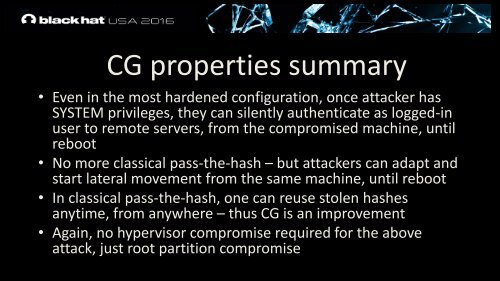ANALYSIS OF THE ATTACK SURFACE OF WINDOWS 10 VIRTUALIZATION-BASED SECURITY
us-16-Wojtczuk-Analysis-Of-The-Attack-Surface-Of-Windows-10-Virtualization-Based-Security us-16-Wojtczuk-Analysis-Of-The-Attack-Surface-Of-Windows-10-Virtualization-Based-Security
aCG properties summary • Even in the most hardened configuration, once attacker has SYSTEM privileges, they can silently authenticate as logged-in user to remote servers, from the compromised machine, until reboot • No more classical pass-the-hash – but attackers can adapt and start lateral movement from the same machine, until reboot • In classical pass-the-hash, one can reuse stolen hashes anytime, from anywhere – thus CG is an improvement • Again, no hypervisor compromise required for the above attack, just root partition compromise
VBS-enforced code integrity • Windows 10 can enforce code integrity of usermode binaries, usermode scripts and kernelmode code; the latter via VBS • We focus on kernelmode case • The goal – not allow execution of any unsigned code in kernel context, even if the kernel has been compromised
- Page 1 and 2: Rafal Wojtczuk rafal@bromium.com AN
- Page 3 and 4: aScopeupa • Most of this research
- Page 5 and 6: aCredential Guard architectureupa P
- Page 7 and 8: aCG scenario 1upa • Admins just e
- Page 9 and 10: aNtlmIumProtectCredentialupa • In
- Page 11 and 12: aScenario 1 propertiesupa • After
- Page 13 and 14: aCG scenario 2upa • Credential Gu
- Page 15: aScenario 2 properties • No more
- Page 19 and 20: Mixing signed & unsigned code • C
- Page 21 and 22: Kernel HVCI and kernel exploits •
- Page 23 and 24: Kernel HVCI bypass, MS16-066
- Page 25 and 26: [Un]usual threat model • Usual mo
- Page 27 and 28: Root partition privileges • Acces
- Page 29 and 30: Root partition privileges • I/O p
- Page 31 and 32: Problem 1 - unfiltered MMCFG • MM
- Page 33 and 34: Problem 2 - chipset registers • S
- Page 35 and 36: S4 sleep • S4 is even more fragil
- Page 37 and 38: SMM • SMM is highly-privileged mo
- Page 39 and 40: SMM • It is well-known that SMM v
- Page 41 and 42: SMM abuse example
- Page 43 and 44: Summary • Despite its limited sco
- Page 45 and 46: Extra slides: Non-VBS-specific •
- Page 47: Other funny chipset capabilities
aCG properties summary<br />
• Even in the most hardened configuration, once attacker has<br />
SYSTEM privileges, they can silently authenticate as logged-in<br />
user to remote servers, from the compromised machine, until<br />
reboot<br />
• No more classical pass-the-hash – but attackers can adapt and<br />
start lateral movement from the same machine, until reboot<br />
• In classical pass-the-hash, one can reuse stolen hashes<br />
anytime, from anywhere – thus CG is an improvement<br />
• Again, no hypervisor compromise required for the above<br />
attack, just root partition compromise



